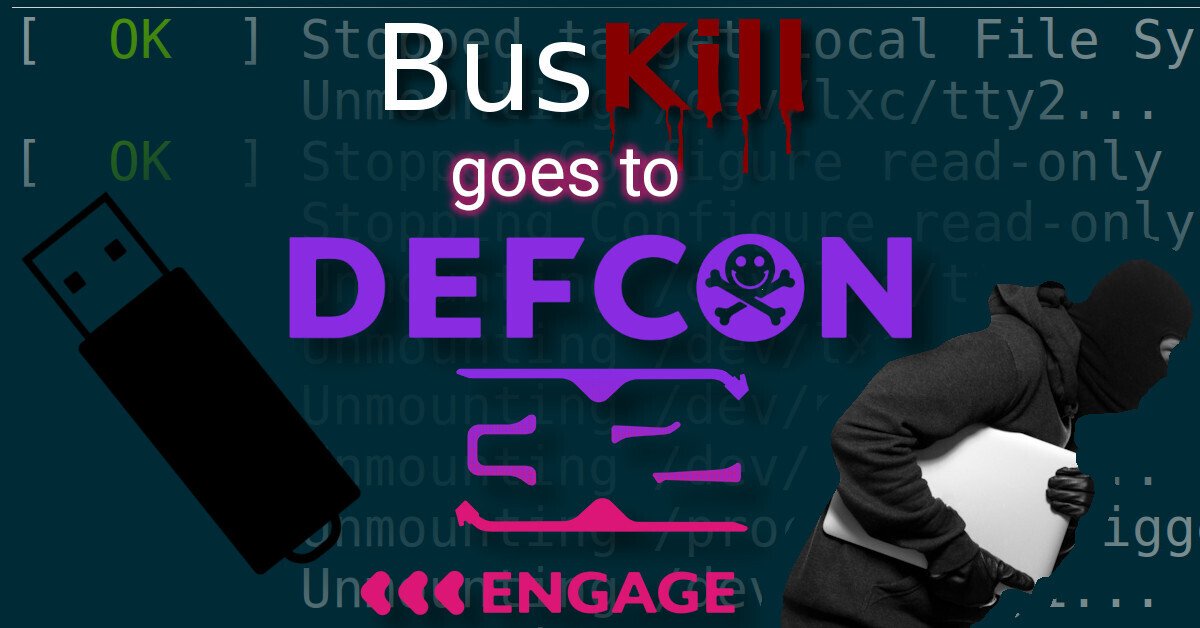We’re very happy to share Techlore’s video review of the BusKill Kill Cord.
Can’t see video above? Watch it on PeerTube at neat.tube or on YouTube at youtu.be/Zns0xObbOPM
We’re very happy to share Techlore’s video review of the BusKill Kill Cord.
Can’t see video above? Watch it on PeerTube at neat.tube or on YouTube at youtu.be/Zns0xObbOPM
🇳🇱 Nederlandse versie van dit artikel
🇫🇷 Version française de cet article
🇩🇪 Deutsche Version dieses Artikels
We’re happy to announce that BusKill cables can now be purchased in-person in Haaksbergen, Netherlands.
The BusKill project has partnered with NovaCustom to make BusKill laptop kill cords available from another brick-and-mortar location in Europe. You can now go to the following location and purchase a BusKill cable with cash or cryptocurrency.
NovaCustom B.V.
Harmoleweg 4
7482 PL Haaksbergen
Netherlands
(only by appointment)
🇬🇧 English version of this article.
🇳🇱 Nederlandse versie van dit artikel
🇩🇪 Deutsche Version dieses Artikels
Nous sommes heureux d’annoncer que les câbles BusKill peuvent désormais être achetés en personne à Haaksbergen, aux Pays-Bas.
🇬🇧 English version of this article.
🇫🇷 Version française de cet article
🇩🇪 Deutsche Version dieses Artikels
We kunnen met trots mededelen dat de BusKill-kabels vanaf nu bij het bedrijf NovaCustom persoonlijk aan te schaffen zijn in Haaksbergen, Nederland.
🇬🇧 English version of this article.
🇳🇱 Nederlandse versie van dit artikel
🇫🇷 Version française de cet article
Mit großem Stolz präsentieren wir unsere neue Zusammenarbeit mit NovaCustom. Ab jetzt können Buskill-Kabel physisch im Büro bei NovaCustom in Haaksbergen (Niederlande) gekauft werden.
In celebration of Bitcoin Black Friday 2024, we’re offering a 10% discount on all BusKill cables sold between Nov 23 to Dec 07.
We’re happy to announce that BusKill is presenting at DEF CON 32.
What: Open Hardware Design for BusKill Cord
When: 2024-08-10 12:00 – 13:45
Where: W303 – Third Floor – LVCC West Hall

Update 2024-09-04 Added slide deck pdf
Today we’re ecstatic to publish our first demo showing a homemade BusKill Cable (in the prototype 3D-printed case) triggering a lockscreen.
While we do what we can to allow at-risk folks to purchase BusKill cables anonymously, there is always the risk of interdiction.
We don’t consider hologram stickers or tamper-evident tape/crisps/glitter to be sufficient solutions to supply-chain security. Rather, the solution to these attacks is to build open-source, easily inspectable hardware whose integrity can be validated without damaging the device and without sophisticated technology.
Actually, the best way to confirm the integrity of your hardware is to build it yourself. Fortunately, BusKill doesn’t have any circuit boards, microcontrollers, or silicon; it’s trivial to print your own BusKill cable — which is essentially a USB extension cable with a magnetic breakaway in the middle
Mitigating interdiction via 3D printing is one of many reasons that Melanie Allen has been diligently working on prototyping a 3D-printable BusKill cable this year. In this article, we hope to showcase her progress and provide you with some OpenSCAD and .stl files you can use to build your own version of the prototype, if you want to help us test and improve the design.
ⓘ Note: This post is adapted from its original article on Melanie Allen’s blog.
In our last update, I showed a video demo where I succesfully triggered a lockscreen using a BusKill prototype without the 3D-printed body for the case and N35 disc magnets. I realized that the N35 disc magnets were not strong enough. In this update, I show a demo with the prototype built inside a 3D-printed case and with (stronger) N42 and N52 cube magnets.
Can’t see video above? Watch it on PeerTube or on YouTube at youtu.be/vFTQatw94VU
In celebration of Bitcoin Black Friday 2023, we’re offering a 10% discount on all BusKill cables sold between Nov 18 to Dec 03.
This post will describe how to setup keyboard shortcuts in QubesOS so that you can temporarily disarm (pause) the BusKill laptop kill cord.
This allows the user to, for example, go to the bathroom without causing their computer to shutdown or self-destruct.
This is a guide that builds on part one: A Laptop Kill Cord for QubesOS (1/2). Before reading this, you should already be familiar with how to setup udev rules for BusKill on QubesOS.
ⓘ Note: This post is adapted from its original article on Tom Hocker’s blog.
What if someone literally steals your laptop while you’re working with classified information inside a Whonix DispVM? They’d also be able to recover data from previous DispVMs–as Disposable VM’s rootfs virtual files are not securely shredded after your DispVM is destroyed.

Are you a security researcher, journalist, or intelligence operative that works in QubesOS–exploiting Qubes’ brilliant security-through-compartimentalization to keep your data safe? Do you make use of Whonix Disposable VMs for your work? Great! This post is for you.
I’m sure your QubesOS laptop has Full Disk Encryption and you’re using a strong passphrase. But what if someone literally steals your laptop while you’re working with classified information inside a Whonix DispVM? Not only will they get access to all of your AppVM’s private data and the currently-running Whonix DispVM’s data, but there’s a high chance they’d be able to recover data from previous DispVMs–as Disposable VM’s rootfs virtual files (volatile.img) are not securely shredded after your DispVM is destroyed by Qubes!
Let’s say you’re a journalist, activist, whistleblower, or a human rights worker in an oppressive regime. Or an intelligence operative behind enemy lines doing research or preparing a top-secret document behind a locked door. What do you do to protect your data, sources, or assets when the secret police suddenly batter down your door? How quickly can you actually act to shutdown your laptop and shred your RAM and/or FDE encryption keys?
BusKill utilizes a magnetic trip-wire that tethers your body to your laptop. If you suddenly jump to your feet or fall off your chair (in response to the battering ram crashing through your door) or your laptop is ripped off your table by a group of armed thugs, the data bus’ magnetic connection will be severed. This event causes a configurable trigger to execute.
The BusKill trigger can be anything from:
While our last post described how to setup such a system in QubesOS with BusKill, this post will describe how to add keyboard shortcuts to arm & disarm the dead man switch (eg so you can go to the bathroom).